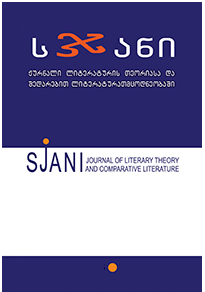Georgian Baroque Tendencies and Besarion Gabashvili’s Poetry
Main Article Content
Abstract
The study aims to analyse Georgian literature from the 16th to 18th centuries in comparison with contemporary European literary tendencies using modern literary methodologies. The 16th to 18th centuries were a crucial and special period in European art as this period is characterised by significant discoveries during the scientific revolution, leading to the disappearance of established aesthetic principles and the emergence of new ways of artistic expression. Baroque, encompassing architecture, sculpture, music, painting, theatre, and literature, was a cultural and art movement that reflected a reaction against humanism and the Renaissance. The movement emphasized dramatic, eclectic, and dynamic motion. Baroque is one of the most significant period of the development of European culture as it laid the foundation of the principles of modernism. Modernism itself is often mentioned as Neo-baroque in literary criticism. In Georgian literary studies, the term “Georgian Baroque” was first mentioned in the 1970s by Giorgi Gachechiladze, who identified Baroque tendencies in Georgian literature.
The term refers to Georgian literature from the 16th to 18th centuries, which exhibits eclecticism and is influenced by Persian literature due to political and economic circumstances. However, despite of significant Persian influence, Georgian literature from the 16th to 17th centuries began to reintegrate into the Western cultural-literary space. We can underline some of the key factors: in Georgian literary texts of 16-18th centuries the chronotope of a foreign country and foreign theme is sublimated with a national thematics (“The Martyrdom of the Holy Queen Qetevan” by Teimuraz I, “War of Aspindza” and “War of Rukhisi” by Besarion Gabashvili). Besides, Georgian texts of these period reflects the crisis of humanism aesthetic and reveals the onto-existential problems of the epoch. One of the most important aspects is that, despite the Persian influence, Christian themes gradually reemerge in Georgian literature and eventually take on pagan characteristics. These factors indicate both the political and literary choices made by Georgia during this period.
Besarion Gabashvili, an influential Georgian poet, philosopher, and diplomat of the 18th century, is well-known for his love poems. He was a close person at the court of King Erekle’s palace, and also played an important role in the contemporary Georgian political arena as he was the ambassador of Eastern Georgia to the Russian royal court. Like his contemporary writers, Gabashvili’s works are quite eclectic and often reveal contradictory literary paradigms. However, our research underlines that Gabashvili’s works exhibit Western literary tendencies, particularly signs of the Baroque movement. It is worth mentioning that Georgian modernist poets like Titsian Tabidze considered Besik (Baroque) and Nikoloz Baratashvili (Romanticism) to be his literary ancestors. Titsian tabitze’s quote “I plant Flowers of Evil by Baudelaire in the garden of Besik”, which is reffered as a key determinant of Georgian symbolism,
clearly defines the connection between Georgian Modernism and Besik (Besarion Gabashvili). We believe, only this fact indicates that we should study Besarion Gabashvili’s poetry in the context of Baroque movement.
In the works of Besarion Gabashvili tendencies of Baroque can be detected both on the philosophical-thematic and on the stylistic levels. His poetry is diverse in terms of genres and themes. He wrote two poems abput national thematics: “War of Aspindza” and “War of Rukhishi”. In these poems chronotope is real and the characters are real historical persons. So, the unrealistic chronotope is sublimated by the real historical events. This tendency was first revealed in the works by Teimuraz I (Martyrdom of Queen Ketevan), whith this in mind, works by Besarion Gabashvili continues this literary tendency, which is also revealed in contemporary Western
literary space.
Another significant factor is the fact that Christian and Biblical symbolic emerges powerfully in his works. Moreover, historical and existential problems are often related to Biblical original sin, which is one of the key philosophical aspects of Baroque aesthetics. Biblical and Ghospel symbolics are highly reflected in the ode dedicated to the mother of God, where Maryam is mentioned as holy and sacred mother of crucified Jesus.
According to Besarion Gabashvili’s poetry, life is governed by fate, which is a devilish event. This contradicts the humanistic model of world perception, which believed that evil will be always defeated by kindness. In works by Besarion Gabashvili a metaphor of a human is a traveler who travels all along the world in both real and phantastic chronotope, but he can never find a peaceful place and concludes that the world is a destructive place and man is doomed to suffer. Even love is also an expression of suffering - the lover always rejects the lyrical hero.
Based on the analysis of the works by Besarion Gabashvili, we can underline that the emergence of Baroque tendencies is a natural and logical event for Georgian literature. The fact finds connection with theory of polygenesis mentioned by Walter Moser. The theory suggests that Baroque tendencies emerged independently in different European countries according to the common background of the historicalphilosophical crisis of the region.
